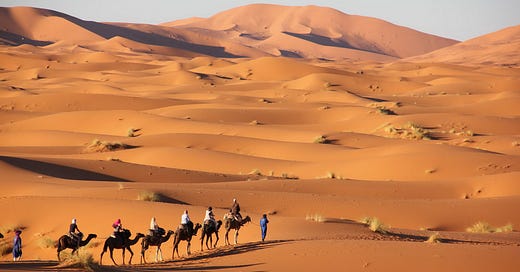TheGentleLaw Community
When we think of Buddhism, our minds often drift to images of quiet temples nestled in Himalayan valleys, golden stupas glistening in Thai forests, or monks walking mindfully through bamboo groves in Japan. But in recent years, a small yet meaningful Buddhist presence has begun to grow in a very different environment: the vast and arid expanses of the Sahara Desert.
Buddhism in Unexpected Places
The Sahara, with its scorching days, freezing nights, and windswept silence, might seem like the last place one would expect to find the teachings of the Buddha. Yet it is precisely this raw, elemental landscape that is attracting a new kind of spiritual seeker. The emptiness of the desert, like the stillness of the meditation hall, becomes fertile ground for insight.
Buddhist Groups in North Africa
Morocco and Algeria have seen a slow but noticeable emergence of small Buddhist sanghas. In urban centers like Marrakech and Casablanca, international practitioners, especially those from France, Spain, and Vietnam, have established meditation circles. Occasionally, these groups organize retreats in desert regions such as the Draa Valley or the dunes of Merzouga.
One such retreat, held annually near Zagora, gathers mindfulness practitioners from across Europe and North Africa for a week of silence and meditation in nomadic tents. Days begin and end with the ringing of a Tibetan bell, and the rhythm of walking meditation is harmonized with the pace of desert winds.
Dharma in the Desert: A Natural Union
There is a certain poetic resonance between the desert and the Dharma. The Buddha taught impermanence (anicca), the truth that all things change and pass away. What better place to observe this than in the Sahara, where dunes shift nightly, and temperatures swing wildly in a single day? Practitioners often speak of a profound confrontation with the self when surrounded by the minimalism of sand and sky.
Moreover, the desert's sparseness mirrors the monastic ideals of renunciation and simplicity. In many ways, these Saharan Buddhist experiments resemble the Buddha's own early life, when he left the palace to wander the forests of India with nothing but a robe and bowl.
Nomadic Mindfulness
Some Buddhist groups in the region have begun integrating elements of North African nomadic traditions into their practice. Movement through the desert becomes a form of mindful walking. Sharing tea around a fire becomes a moment of interbeing. The silence of the dunes offers a sanctuary for vipassanā meditation and reflection.
There are even stories of local Amazigh (Berber) families welcoming these groups, intrigued by the similarities between their own mystical traditions and the meditative calm of the Buddhists. While conversions are rare, there is a growing mutual curiosity and respect.
Challenges and Hope
The rise of Buddhism in North Africa is not without its challenges. Official recognition is limited in many countries, and public religious practice outside of Islam can be sensitive. However, the private nature of Buddhist practice—centered on silence, introspection, and ethical living—has allowed it to quietly coexist with local cultures.
International Buddhist organizations such as Plum Village and the Triratna Order have occasionally supported initiatives in the region. Some practitioners from Europe and Sub-Saharan Africa are exploring ways to establish permanent retreat centers near the edge of the desert, though logistical and legal hurdles remain.
A New Frontier for the Dharma
The Sahara may not become the next Bodh Gaya, but it is fast becoming a unique spiritual frontier. In its harsh beauty, the desert invites humility. In its silence, it nurtures listening. And in its vastness, it offers a rare glimpse of emptiness—not as something to fear, but as something to understand and embrace.
Buddhism in the Sahara is still young, fragile, and evolving. Yet its presence there reminds us that the Dharma is not a relic of the East but a living path that can adapt, grow, and flourish anywhere—even among the dunes.





